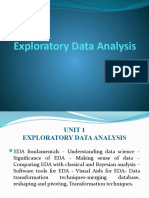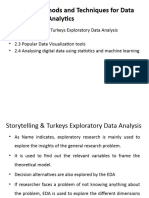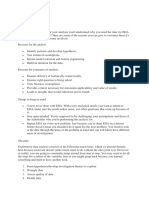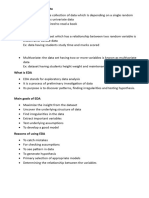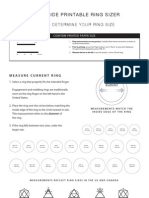[AI6322/ Processes of Intelligent `1 Exploratory
Data Analysis] Data Analysis (EDA)
MODULE 03 - EXPLORATORY DATA ANALYSIS (EDA)
Module Objectives
At the end of this module, you are expected:
1. Define EDA.
2. Highlight importance of visualizing data patterns.
3. Apply EDA tools to explore variable relationships.
4. Analyze insights from EDA for meaningful conclusions.
5. Evaluate EDA methods for effectiveness.
6. Create EDA plan for thorough dataset analysis.
3.1 Mastering Exploratory Data Analysis (EDA)
3.1.1 Introduction
3.1.1.1 Definition of EDA
Exploratory Data Analysis (EDA) is a crucial phase in data analysis
where analysts summarize the main characteristics of a dataset, often
utilizing visual methods. It involves techniques to understand the
underlying structure, patterns, and anomalies in the data before formal
modeling or hypothesis testing.
3.1.1.2 Importance of EDA in data analysis
EDA plays a pivotal role in the data analysis process for several
reasons
1. Data Understanding: It helps analysts to gain an initial understanding
of the data, its distribution, and its potential challenges
| Course Module
� [AI6322/ Processes of Intelligent `2 Exploratory
Data Analysis] Data Analysis (EDA)
2. Data Quality Assessment: EDA aids in identifying data quality issues
such as missing values, outliers, or inconsistencies.
3. Pattern Recognition: Through visualization and summary statistics,
EDA allows analysts to identify patterns, trends, or relationships within the
data.
4. Hypothesis Generation: EDA can inspire hypotheses for further
investigation, guiding subsequent modeling and testing.
5. Insight Generation: It facilitates the discovery of insights and
actionable conclusions that can drive decision-making processes.
6. Assumption Checking: EDA helps in validating assumptions required
for more advanced statistical modeling.
7. Communication: Visualizations generated during EDA serve as powerful
tools for communicating findings to stakeholders effectively.
In essence, EDA acts as a crucial preliminary step in extracting
meaningful insights from data, enabling informed decision-making and
further analysis.
3.1.2 Visualizing Data Patterns
3.1.2.1 Understanding data distributions
Data distributions describe how values are spread out or clustered
within a dataset. Common distribution types include normal, uniform,
skewed, and multimodal distributions. Understanding these distributions is
| Course Module
� [AI6322/ Processes of Intelligent `3 Exploratory
Data Analysis] Data Analysis (EDA)
essential for grasping the central tendency, variability, and shape of the
data.
3.1.2.2 Importance of visualizing patterns
Visualizing patterns in data offers several advantages:
1. Clarity: Visual representations provide intuitive insights into complex
datasets, making patterns easier to grasp compared to raw numbers or
tables.
2. Identification of Outliers: Visualizations make it easier to identify
outliers or anomalies that may distort the analysis.
3. Comparison: Visualizations allow for easy comparison between
different variables or datasets, aiding in detecting correlations or
discrepancies.
4. Communication: Visualizations are powerful tools for conveying
findings to stakeholders who may not be familiar with technical details,
facilitating decision-making.
5. Exploratory Analysis: Visual exploration enables analysts to uncover
unexpected relationships or trends, guiding further investigation.
3.1.2.3 Techniques for visual exploration
1. Histograms: Histograms display the frequency distribution of
continuous variables, providing insights into their distribution shape and
central tendency.
| Course Module
� [AI6322/ Processes of Intelligent `4 Exploratory
Data Analysis] Data Analysis (EDA)
2. Box Plots: Box plots summarize the distribution of a variable,
highlighting key statistics such as the median, quartiles, and outliers.
3. Scatter Plots: Scatter plots visualize the relationship between two
continuous variables, revealing patterns such as correlation, clusters, or
outliers.
4. Heatmaps: Heatmaps represent data using color gradients, making it
easy to identify patterns and relationships in large datasets, especially in
correlation matrices.
5. Line Charts: Line charts display trends over time or other ordered
categories, helping to identify patterns and seasonality.
These techniques, among others, empower analysts to explore data
visually, uncover insights, and communicate findings effectively.
3.1.3 Exploring Variable Relationships
3.1.3.1 Utilizing EDA tools
Exploratory Data Analysis (EDA) tools facilitate the exploration of
relationships between variables in a dataset. These tools often include
statistical methods, visualizations, and interactive interfaces that enable
analysts to gain insights into the data's structure and patterns.
3.1.3.2 Analyzing correlations between variables
| Course Module
� [AI6322/ Processes of Intelligent `5 Exploratory
Data Analysis] Data Analysis (EDA)
Correlation analysis is a fundamental technique in EDA for examining
relationships between variables. Key aspects include:
1. Pearson Correlation: Measures the linear relationship between two
continuous variables, ranging from -1 to 1.
2. Spearman Correlation: Assesses the monotonic relationship between
variables, suitable for ordinal or non-normally distributed data.
3. Correlation Matrix: Visualizes correlations between multiple variables
simultaneously, often using color gradients to indicate strength and
direction.
4. Scatter Plots: Graphical representation of the relationship between
two variables, useful for identifying patterns such as positive, negative, or
no correlation.
3.1.3.3 Uncovering hidden connections
EDA techniques can reveal hidden connections between variables that
may not be immediately apparent. This can be achieved through:
1. Feature Engineering: Creating new variables or transformations
based on existing ones to better capture relationships or patterns in the
data.
2. Dimensionality Reduction: Techniques like Principal Component
Analysis (PCA) or t-Distributed Stochastic Neighbor Embedding (t-SNE)
help identify underlying structures and relationships in high-dimensional
data.
| Course Module
� [AI6322/ Processes of Intelligent `6 Exploratory
Data Analysis] Data Analysis (EDA)
3. Clustering: Grouping similar observations based on their features can
uncover natural relationships or clusters within the data.
4. Network Analysis: Exploring relationships between entities using
graph-based approaches can reveal complex connections and dependencies.
By employing these techniques, analysts can delve deeper into the
relationships between variables, uncover hidden connections, and gain a
more comprehensive understanding of the underlying structure of the data.
3.1.4 Analyzing Insights and Trends
3.1.4.1 Identifying key insights
Identifying key insights involves:
1. Pattern Recognition: Recognize recurring patterns, anomalies, or
outliers in the data that deviate from expected norms.
2. Correlation Analysis: Identify relationships between variables that
may indicate causality or dependencies.
3. Statistical Significance: Determine the statistical significance of
observed trends or differences to assess their reliability.
4. Domain Knowledge: Leverage domain expertise to interpret findings
in the context of the specific industry or subject matter.
3.1.4.1 Extracting meaningful conclusions
Extracting meaningful conclusions requires:
| Course Module
� [AI6322/ Processes of Intelligent `7 Exploratory
Data Analysis] Data Analysis (EDA)
1. Contextualization: Place insights within the broader context of the
business objectives, market dynamics, or research goals to derive
actionable conclusions.
2. Impact Assessment: Evaluate the potential impact of the insights on
business outcomes, strategic decisions, or research directions.
3. Risk Consideration: Assess any risks or uncertainties associated with
the conclusions drawn, considering factors such as data limitations,
assumptions, or external factors.
4. Validation: Validate conclusions through further analysis,
experimentation, or consultation with subject matter experts to ensure their
accuracy and relevance.
3.1.4.2 Interpreting trends for decision-making
Interpreting trends for decision-making involves:
1. Forecasting: Use historical trends and patterns to forecast future
outcomes or anticipate changes in market conditions.
2. Scenario Analysis: Explore different scenarios or what-if scenarios
based on identified trends to assess their potential implications and inform
decision-making under uncertainty.
3. Benchmarking: Compare observed trends against industry
benchmarks, competitors' performance, or historical data to gauge
performance relative to peers or standards.
| Course Module
� [AI6322/ Processes of Intelligent `8 Exploratory
Data Analysis] Data Analysis (EDA)
4. Alignment: Ensure alignment between identified trends and
organizational goals, strategic priorities, or research objectives to guide
decision-making effectively.
5. Iterative Process: Treat trend interpretation as an iterative process,
continuously monitoring and updating insights in response to evolving data,
market dynamics, or business needs.
By systematically identifying key insights, extracting meaningful
conclusions, and interpreting trends for decision-making, organizations can
leverage data-driven insights to drive strategic decisions, optimize
performance, and achieve their objectives.
3.1.5 Evaluating EDA Methods
3.1.5.1 Assessing effectiveness of techniques
Evaluating the effectiveness of EDA techniques involves several
considerations:
1. Insight Generation: Assess whether the techniques provide
meaningful insights into the data, helping to uncover patterns, trends, or
anomalies.
2. Ease of Interpretation: Evaluate how easily stakeholders can
interpret the results generated by the techniques, considering factors such
as clarity of visualizations and intuitiveness of summaries.
3. Scalability: Determine whether the techniques can handle large
datasets efficiently without sacrificing performance or accuracy.
| Course Module
� [AI6322/ Processes of Intelligent `9 Exploratory
Data Analysis] Data Analysis (EDA)
4. Robustness: Assess the resilience of the techniques to different types
of data and potential outliers or missing values.
5. Complementarity: Consider how well the techniques complement
each other, providing a holistic view of the data from multiple perspectives.
3.1.5.2 Comparing different EDA tools
When comparing EDA tools, it's essential to evaluate various aspects:
1. Functionality: Assess the range of features and techniques offered by
each tool, including visualization options, statistical summaries, and
interactive capabilities.
2. Usability: Consider the user interface design, ease of navigation, and
availability of tutorials or documentation to support users in effectively
utilizing the tool.
3. Performance: Evaluate the speed and efficiency of the tool in handling
different sizes and types of datasets, as well as its compatibility with various
data formats.
4. Customization: Determine the extent to which users can customize
analyses and visualizations to meet their specific requirements and
preferences.
| Course Module
� [AI6322/ Processes of Intelligent `10 Exploratory
Data Analysis] Data Analysis (EDA)
5. Community Support: Take into account the availability of user
communities, forums, and support resources that can assist users in
troubleshooting issues or sharing best practices.
3.1.5.2 Optimizing analysis processes
To optimize EDA processes, consider the following strategies:
1. Automation: Utilize automation tools and scripts to streamline
repetitive tasks, such as data preprocessing, visualization generation, and
summary statistics calculation.
2. Parallelization: Explore parallel computing techniques to speed up
computations and analyses, especially for large datasets or complex
algorithms.
3. Feedback Loop: Establish a feedback loop with stakeholders to
continuously refine and improve EDA techniques based on their insights,
suggestions, and evolving data needs.
4. Documentation: Document EDA workflows, assumptions, and findings
systematically to ensure reproducibility and facilitate knowledge sharing
within the team.
5. Continuous Learning: Stay updated with advancements in EDA
methods, tools, and best practices through training, conferences, and
professional development opportunities.
By carefully evaluating EDA methods, comparing tools, and optimizing
analysis processes, analysts can enhance the efficiency and effectiveness of
| Course Module
� [AI6322/ Processes of Intelligent `11 Exploratory
Data Analysis] Data Analysis (EDA)
exploratory data analysis, leading to more insightful and actionable insights
from the data.
3.1.6 Creating an EDA Plan
3.1.6.1 Structuring a comprehensive analysis
Structuring a comprehensive EDA involves:
1. Objective Definition: Clearly define the goals and objectives of the
analysis, including the questions to be answered and the insights to be
gained.
2. Scope Definition: Determine the scope of the analysis, including the
timeframe, data sources, and variables to be included.
3. Team Formation: Assemble a multidisciplinary team with expertise in
data analysis, domain knowledge, and technical skills necessary for the
analysis.
4. Resource Allocation: Allocate resources such as time, budget, and
tools necessary to execute the analysis effectively.
5. Timeline Development: Develop a timeline outlining key milestones,
deliverables, and deadlines for the analysis process.
3.1.6.2 Outlining steps and techniques
Outlining steps and techniques involves:
| Course Module
� [AI6322/ Processes of Intelligent `12 Exploratory
Data Analysis] Data Analysis (EDA)
1. Data Collection: Gather relevant data from various sources, ensuring
data integrity, completeness, and accuracy.
2. Data Cleaning: Preprocess the data to handle missing values, outliers,
and inconsistencies, ensuring data quality and consistency.
3. Exploratory Data Analysis (EDA): Conduct EDA using techniques
such as histograms, scatter plots, correlation analysis, and clustering to
explore the data's structure, patterns, and relationships.
4. Feature Engineering: Create new features or transformations based
on existing ones to enhance predictive power or capture underlying
patterns in the data.
5. Model Selection: Select appropriate modeling techniques based on
the analysis goals and data characteristics, such as regression,
classification, or clustering.
6. Model Evaluation: Evaluate model performance using metrics such as
accuracy, precision, recall, or RMSE to assess predictive power and
generalization capability.
3.1.6.3 Ensuring thorough dataset examination
Ensuring thorough dataset examination involves:
1. Data Summary: Summarize key characteristics of the dataset,
including descriptive statistics, data distributions, and variable summaries.
2. Visualization: Visualize data using various graphical techniques to
identify patterns, trends, outliers, and relationships.
| Course Module
� [AI6322/ Processes of Intelligent `13 Exploratory
Data Analysis] Data Analysis (EDA)
3. Correlation Analysis: Analyze correlations between variables to
understand dependencies and identify potential predictors or confounding
factors.
4. Validation: Validate findings through sensitivity analysis, cross-
validation, or comparison with external benchmarks to ensure robustness
and reliability.
5. Documentation: Document the analysis process, assumptions,
methodologies, and findings systematically to ensure transparency,
reproducibility, and knowledge sharing.
By following a structured EDA plan that includes comprehensive
analysis structuring, outlining of steps and techniques, and ensuring
thorough dataset examination, organizations can extract meaningful
insights from their data to inform decision-making and drive business
success.
| Course Module
� [AI6322/ Processes of Intelligent `14 Exploratory
Data Analysis] Data Analysis (EDA)
References and Supplementary Materials
Online Supplementary Reading Materials
Becker, R. L., & Cleveland, W. S. (1988). Data cleaning: Rules and best
practices. Duxbury Press.
Bertsimas, D. P., & Tsitsiklis, J. N. (2015). Automated machine learning.
Athena Scientific.
Chawla, N. V., Bowyer, K. W., Hall, L. O., & Kegelmeyer, W. P. (2005).
Ensemble methods in machine learning. Springer.
Gelman, A., & Hill, J. (2007). Exploratory data analysis: An introduction
(2nd ed.). Chapman and Hall/CRC.
Géron, A. (2017). Hands-on machine learning with Scikit-Learn, Keras &
TensorFlow: Concepts, tools, and techniques to build intelligent
systems (1st ed.). O'Reilly Media.
| Course Module
� [AI6322/ Processes of Intelligent `15 Exploratory
Data Analysis] Data Analysis (EDA)
Géron, A. C. (2019). Feature engineering for machine learning. O'Reilly
Media.
Goodfellow, I., Bengio, Y., & Courville, A. (2016). Deep learning (1st ed.).
MIT Press.
Hastie, T., Tibshirani, R., & Friedman, J. (2009). The elements of statistical
learning (2nd ed.). Springer Series in Statistics.
Hyndman, R. J., & Athanasopoulos, G. (2018). Forecasting: Principles and
practice (3rd ed.). Now Publishers.
Jurafsky, D., & Martin, J. H. (2020). Speech and language processing (3rd
ed.). Pearson Education Limited.
Kotu, V., Rao, V. R., & Krishna, K. (2010). Case studies in machine learning.
Cambridge University Press.
Molnar, C. (2020). Interpretable machine learning: A guide for making
black box models explainable. Wiley.
Müller, A. C., & Guido, S. (2017). Introduction to machine learning with
Python: A guide for data scientists (1st ed.). Springer.
Provost, F., & Fawcett, T. (2013). Data science for business: Forecasting
model selection and performance evaluation. Wiley.
| Course Module











